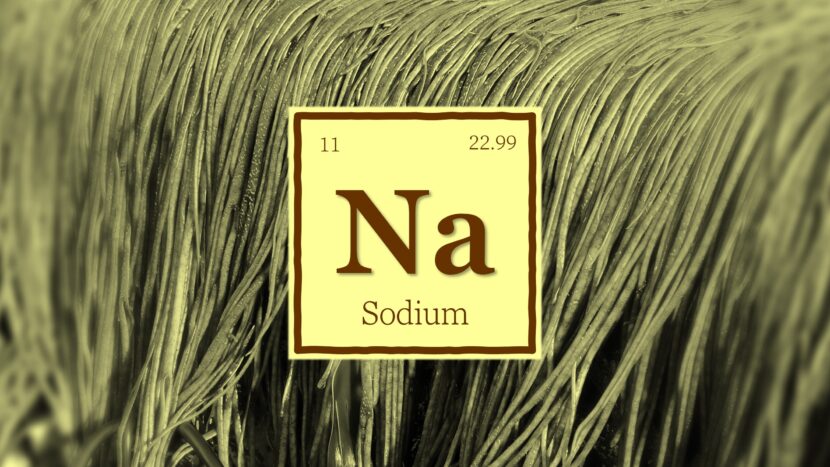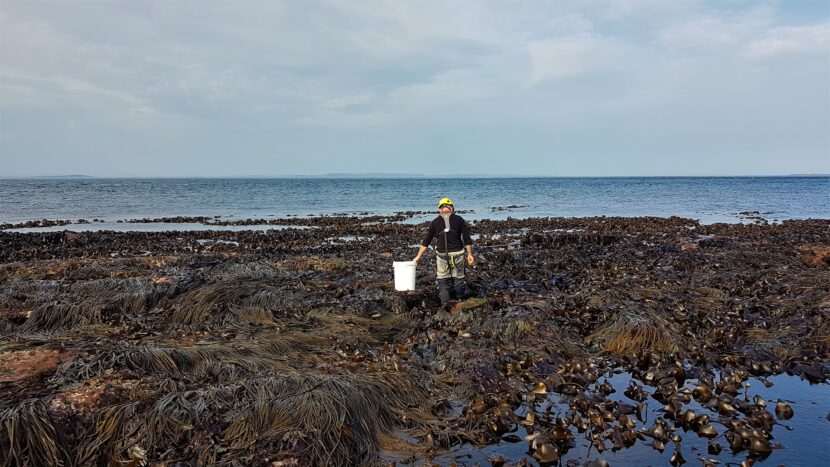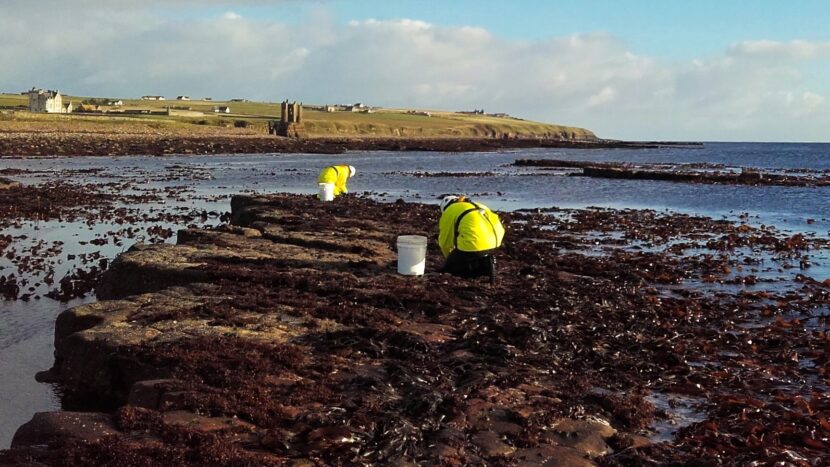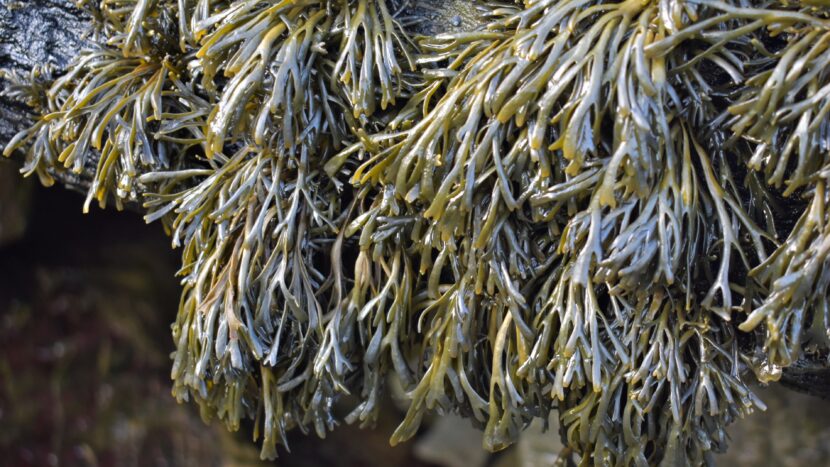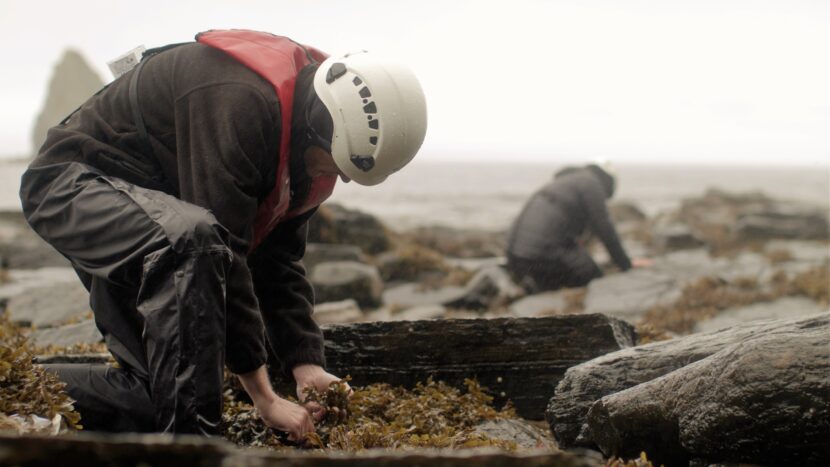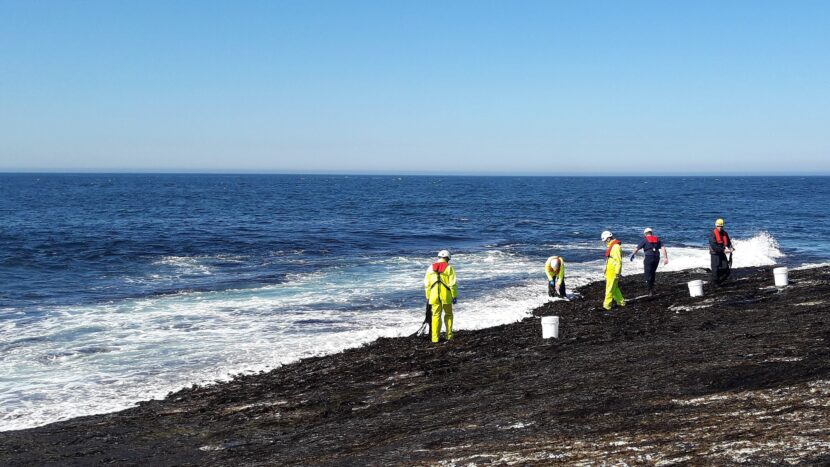Species spotlight: dulse
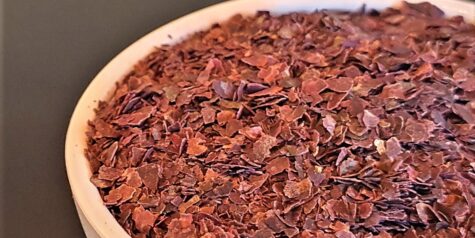
For this Species Spotlight article, Peter Elbourne provides insight on dulse – known by scientists as Palmaria palmata. Dulse is perhaps the most famous edible seaweed native to the north Atlantic. Autumn is the peak of the harvest season for this species and that makes it the ideal time to share some of Horizon Seaweed’s insight on dulse.
Fundamentals of dulse biology
Dulse is one of the edible seaweeds traditionally eaten in coastal communities in northern Europe. While dulse is the most commonly used name, it is also known as dillisk or duileasc in Irish Gaelic and söl or søl in Scandinavian languages. Monks living on the Island of Iona of the west coast of Scotland are documented to have eaten dulse 1,400 years ago.

Dulse can grow abundantly on the low intertidal zone, but is often found higher up on the mid shore
As part of the red seaweed family, dulse is actually distantly related to the wracks and kelps that make up the majority of the biomass in our harvest quotas. The colour is interesting in itself because it is quite variable. Dulse will often be a very dark red, but younger plants usually have a lighter colour. There are more purple tones when submerged, perhaps because of how different wavelengths of light are absorbed under water.
It has a flat frond growing directly from a small holdfast. Individuals in more exposed locations will usually only reach around 20cm, but it can grow to as long as 50cm in perfect conditions. Dulse can be found quite high up the shore, nearly reaching the middle of the intertidal zone. It will tend to be more abundant on the low shore, continuing to be found down to around 20m depths.
Dulse has a complex life cycle – to which we will return – with peak fertility during the winter months. As with all seaweeds, older plants tend to become covered with marine life. This includes bryozoans, also known as sea mats, and other algae that compete with their host for nutrients and light.
Harvesting
When thinking of seaweed harvesting, we imagine seaweed growing on rocks. Dulse is known as an early colonising species, quickly settling on bare rock. It is grazed by limpets and sea snails and this makes the density of dulse on rocks quite variable. Dulse will grow well on and around boulders because plants can hang over the edges. Our harvesters sometimes find a thick patch of dulse, but we will not necessarily expect it to be there the following year. A heritage for dulse harvesting – known as dulsing – continues in rural coastal areas. Amongst the wild harvesting community, we often hear dulse described with adjectives like capricious and ephemeral. An example of this is New Brunswick on the Altantic coast of Canada, where there was a relatively poor dulse season in 2023. Dulse can be an unpredictable seaweed!

A dense patch of dulse covering a flat rocky shelf on one of our harvest sites in Caithness
The majority of dulse we pick actually grows on other varieties of seaweed. This form is known as epiphytic, which means plant surface, as opposed to the epilithic dulse found attached to rocks. Raised up in the water column, plants are in an ecological niche with improved water flow and protection from grazing marine life. Dulse is well known for growing on the long rigid stems of kelp – called stipes – down at the very bottom of the shore: a species we call tangle with the scientific name Laminaria hyperborea. It also grows well on species like toothed wrack higher up the intertidal zone.
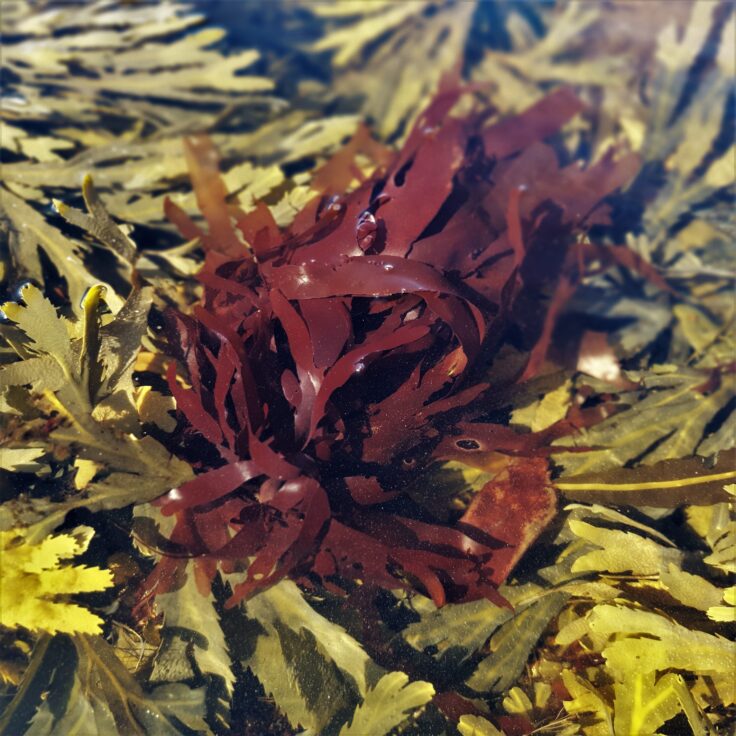
We target dulse growing on other seaweed, such as toothed wrack, to maximise quality at point of harvest
Dulse is present on all of our sites, but because they are small plants they need to be abundant to be harvestable. What we have learned over time is that some beaches simply do not carry enough biomass to be viable for dulse. Although we have harvested dulse at 13 sites over the years, most have been used for just a few trips. Three sites account for two-thirds of harvests to date and it is no coincidence that they are adjacent to each other, running along the north coast of Caithness where the rocky shelves are sheltered from the worst storms. Much of the coastline here has boulders that are swept by the strong tidal races through the Pentland Firth: these are ideal conditions for dulse. There are some very useful sites elsewhere around Caithness, especially for catching strong spring tides that fall in early mornings (e.g. Ness of Duncansby).
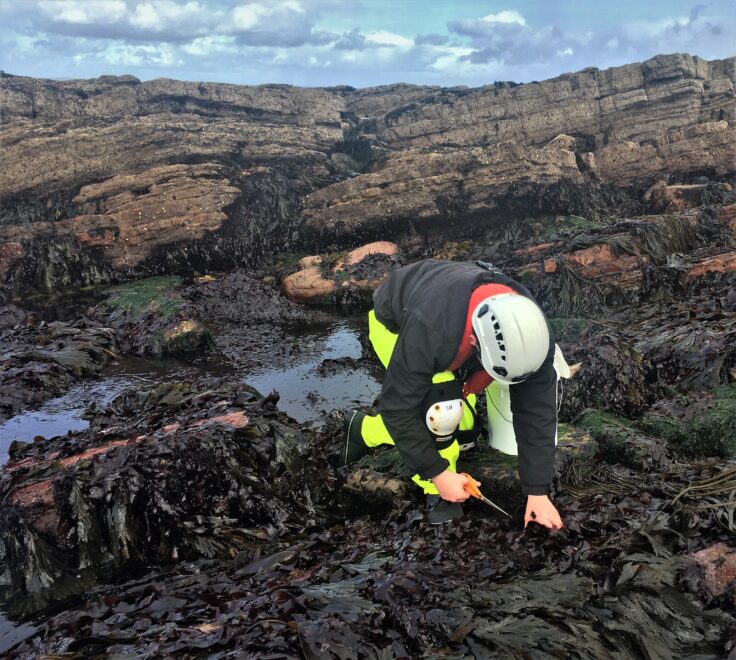
Hand harvesting dulse at low tide on the north coast of Scotland
Operations are always geared around maximising harvest of this key species as summer turns to autumn. We completed our 400th dulse harvest in September 2024. This large number is partly because we often split the team between two sites. Picking rates are slow compared to other species and are further hit if harvesters work closely side by side. It is important to spread out! There are also many tides where dulse is a possibility rather than a probability, which is when we will do a small harvest and top up with a variety of wrack higher up the shore.
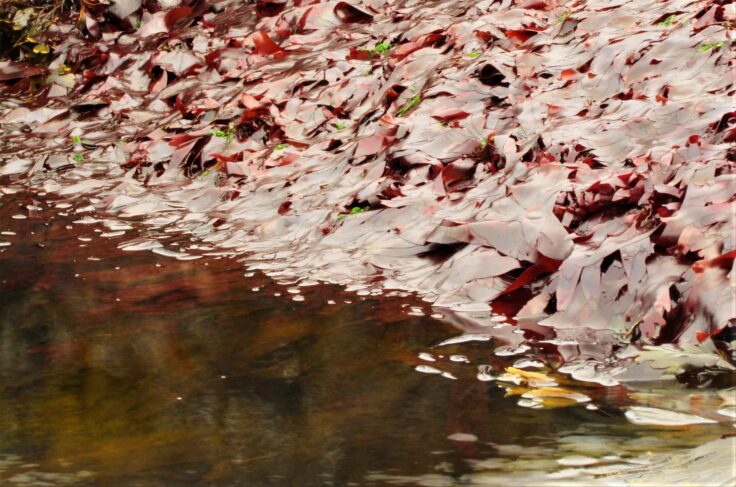
A patch of dulse exposed by a falling tide
Processing dulse: size and colour matter
Dulse usually dries without any particular difficulty, although we will always push to maximise throughput during a spring tide week. However, dried dulse is very bulky and has a texture that slows down the milling process. This is why we usually leave size reduction to neap tide weeks. Dulse tends to produce larger flakes than other species.

Larger flakes of dulse (Cut #4) by finer milled dulse (Cut #7)
We sometimes receive comments regarding the dark colour of our dulse. This is because we dry in rooms with controlled conditions. Dulse is traditionally dried outside, with exposure to the sun bleaching the seaweed and turning it a lighter purple. We have noticed this change in dried dulse left out on a desk for a few days. While a bright colour might look good on the plate, this is actually a sign that pigments within the dulse have degraded. It is why we store our seaweed in dark containers. In our view, darker coloured dulse is a sign of higher quality.
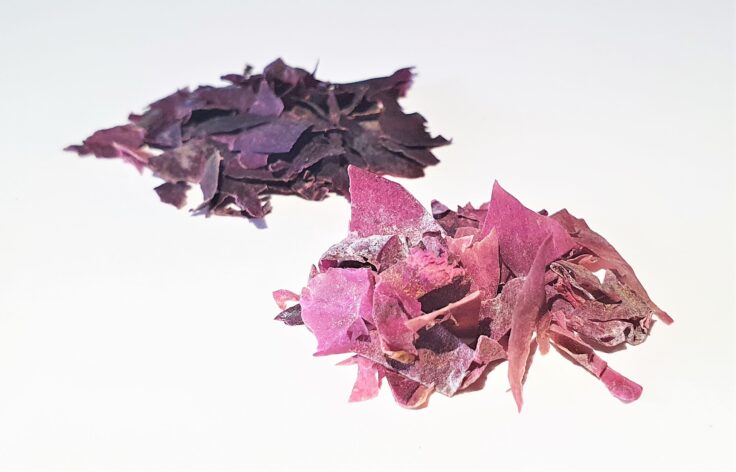
Dark purple dulse may change to a pink hue if dried outside or not stored in the dark.
Interesting bioactive components
Dulse has relatively high levels of a red protein-pigment complex called phycoerythrin, which is used as a colourant in foods and cosmetics. It is actually one of the brightest fluorescent dyes yet discovered and this property is utilised in analytical laboratory techniques. Phycoerythrin is part of the phycobiliprotein group of compounds and is degraded when drying at high temperature (Stevant, 2019): another reason to source low temperature dried dulse from Horizon Seaweed.
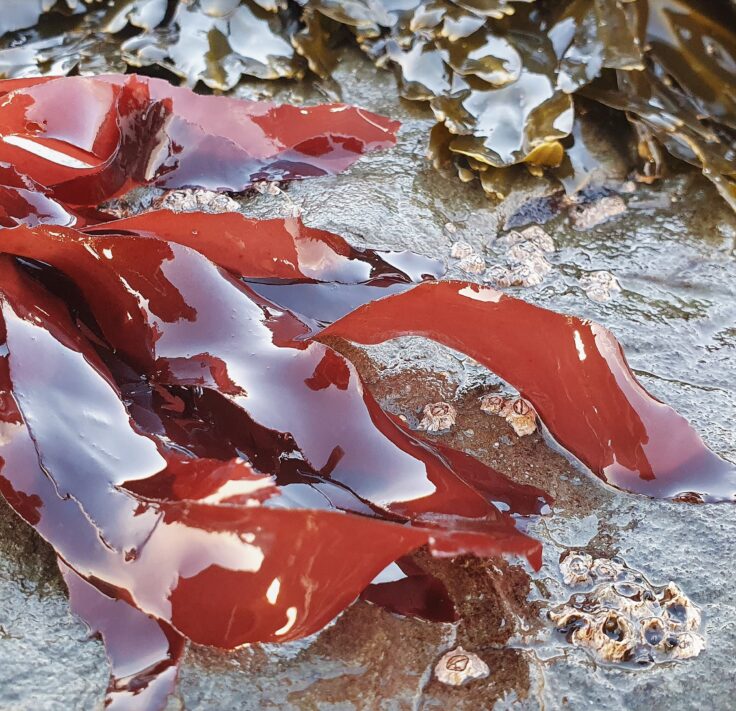
Dulse contains phycoerythrin, a bright red protein-pigment complex
Research on our seaweed found that dulse has lower levels of polyphenols compared to brown seaweeds such as bladder wrack and toothed wrack (Badmus et al., 2022). However, building blocks of proteins in dulse have many interesting uses. The species contains amino acids that have antiproliferative effects on human cells, which could have anti-cancer applications (Athukorala et al 2016). Studies of peptides isolated from dulse have identified activity that could have benefits for diabetics (Harnedy-Rothwell et al., 2021). These do not correspond to health claims connected to consuming the raw seaweed, but they do indicate extraordinary potential for discovery of biocompounds from dulse. Its interesting composition makes this species an exciting candidate for a biorefinery, where plant biomass is taken through a process to optimise the extraction of different material (Gallagher et al., 2020).
Applications for dulse
Dulse is becoming increasingly recognised as a key species for the European seaweed industry. It was seaweed of the year at the 2024 Seagriculture conference in the Faroe Islands! Dulse contains less iodine than most other species. This allows higher inclusion levels in human food applications, while still achieving intake levels to support thyroid health.
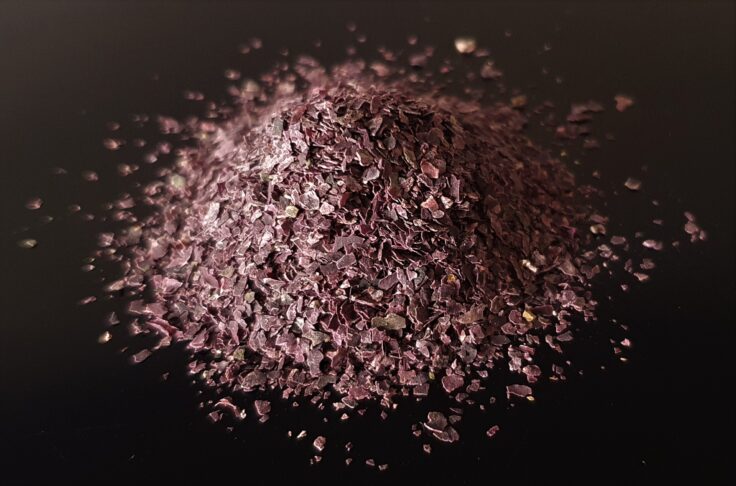
There are many unique bioactives within dulse
Culinary uses
Dulse is no longer a forgotten traditional food of coastal communities: the secret is out! It is one of the few species native to the north Atlantic that has wider name recognition. Put another way, dulse is known as food in its own right. Ingredient search engine SuperCook lists 60 recipes for dulse. It is a feature ingredient for many dishes, including dulse chowder, sunflower and dulse bread and dulse onigiri. One infamous use of dulse is as a vegan bacon, thanks to the crispy texture – once fried – and salty flavour. Perhaps a stretch to consider it as equivalent to the real thing, but it can be used to make a vegan DLT sandwich (dulse, lettuce and tomato).
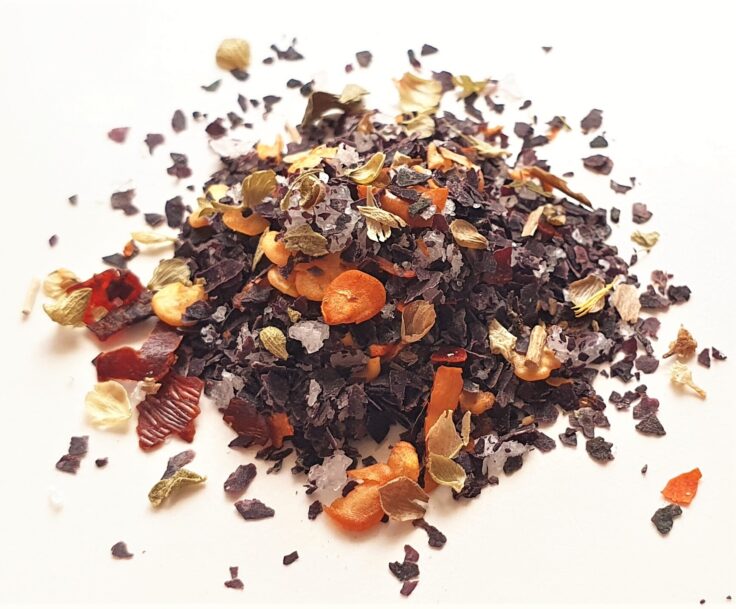
Dulse is a great addition to spice blends, especially if aiming to achieve a vegan seafood flavour
Dulse brings a salty ocean flavour and aroma to dishes. This makes it a coveted ingredient for plant-based seafood, including vegan versions of Mexican stew, fish taco bowl, linguini and clam sauce, tuna salad, lobster roll and even the iconic British fish and chips. Horizon Seaweed supplies dulse to a number of food manufacturers for to impart seafood flavour to vegan dishes.
Dulse for beauty products
Although more commonly used for food and nutrition applications, dulse can also be used in beauty products. Along with almost all of the seaweeds we supply, dulse is listed as a cosmetic ingredients on CosIng: a European Commission database that aims to promote innovation and efficiencies. Dulse is included – under its scientific name Palmaria palmata – for skin protection and for control of viscosity.
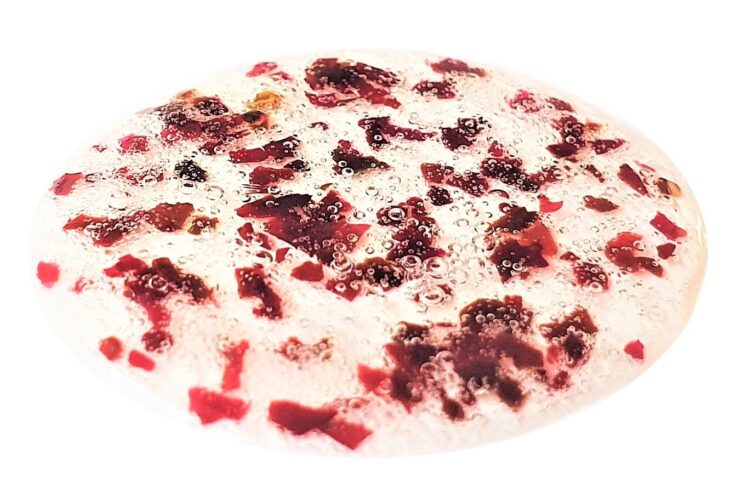
Dulse is a recognised ingredient for cosmetics, both in milled form and as an extract
The challenges of farming dulse
Like other seaweeds, dulse releases spores that are dispersed by currents. Specific environmental cues induce reproduction, including temperature and daylight. The life cycle is certainly convoluted, as it usually is for red seaweeds, featuring tetraspores and gametophytes. The Marine Life Information Network has a summary of the reproductive cycle of dulse. Nevertheless, the complexity makes it harder to reliably produce seed in a hatchery.
Rope cultivation may mimic the epiphytic growth we see with dulse thriving on other seaweed in the wild. The key difference is that the ropes are constantly submerged. We tested dulse during our farming trials, which were focused on larger species of kelp. Unfortunately, we did not manage to get any yield from dulse seed we deployed. We sometimes saw natural settlement, especially on lines lapping the surface. There is no doubt that yield for rope grown dulse will be lower than kelps even when seeding is reliable, which presents a challenge for ocean farming. Do not forget to check out our report on our seaweed cultivation trials.
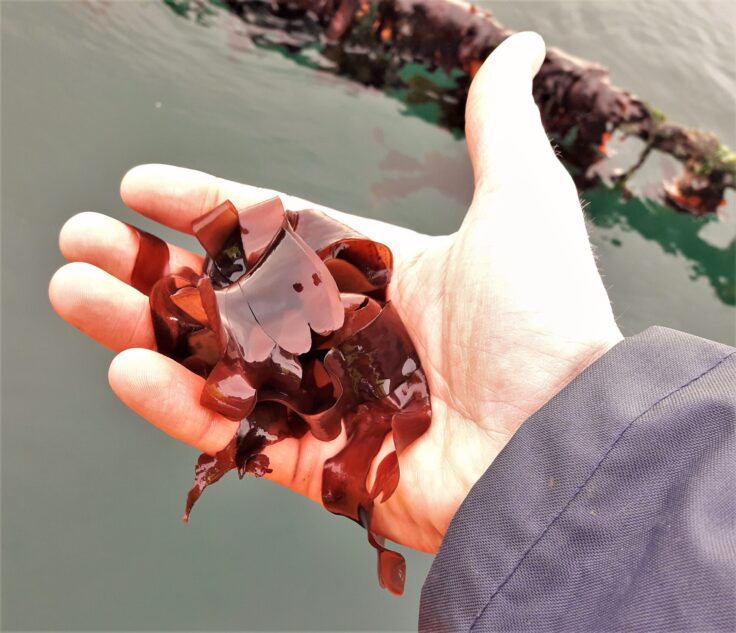
Dulse sometimes naturally settled on surface ropes during our farming trials in Scotland, but targeted cultivation at sea is not straightforward
Dulse can grow quickly in the right conditions. This attribute is being exploited in land-based tank farming, where nutrient and light levels can be controlled to maximise vegetative growth. A recent study estimated growth at 5% per day (Liboureau & Pampanin, 2024). This may not sound particularly fast, but it is enough to double the weight in just two weeks. It is worth noting that this is from small fragments of growth tissue, rather than starting with whole plants. Similar research into cultivated dulse report even higher rates, but this may not be representative. Growth in wild plants is likely to be substantially less: growth averaged <1% per day in a small study in Northern Ireland (Faes & Viejo, 2003).
There is very little cultivation of dulse at present: systems and protocols must be carefully designed to reduce production costs to achieve economic viability. AlgaPlus in Portugal have grown small volumes of dulse in tanks for over a decade. In summer 2024, the pioneering team at Hortimare shared news of their advances in dulse cultivation at sea and on land. This could lead to a step change in European dulse production. Acadian Seaplants in Canada have been adapting their longstanding tank cultivation techniques to dulse. On the Pacific coast, Chuck Toomb’s team at Oregon Seaweed are also making waves with their land-based systems, utilising the related species Develeara mollis. They have developed strains with interesting attributes, including enhanced protein levels and a ‘pom pom’ growth form.

The variety of higher value applications for dulse makes it a target for scaled production
In conclusion
A comprehensive review of dulse was recently published (Stevant et al., 2023), if you are interested in taking a deeper technical dive into the biology and composition of this fascinating species. Please check out our page on dulse and contact us if you would like more information about the dulse we supply. We are always keen to take part in projects investigating compounds within seaweed, especially those that make use of our archive of seaweed samples.
